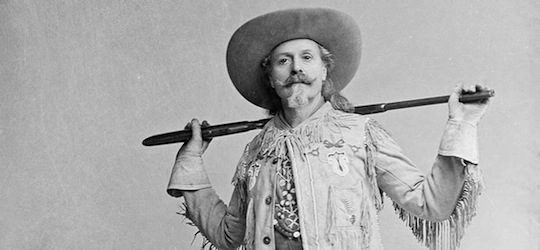These digital research modules, while adjunct to the William F. Cody Archive, are an important part of The Papers of William F. Cody project. Senior Digital Editor, Professor Douglas Seefeldt, working in collaboration with a series Graduate Research Assistants trained in the United States history, the American West, and Digital History theory and methods, directs the development of a set of thematic digital history research initiatives that explore key elements of William F. “Buffalo Bill” Cody’s life and times while presenting new data contributing to the broader area of Cody Studies.
This research agenda makes The Papers of William F. Cody more than simply an archival project as it in turn uses new forms of digital humanities research methods employing digital sources from the William F. Cody Cody Archive to create new data for further interpretation. These researchers have been sharing their findings both online and at a number of scholarly meetings and conferences in the United States and abroad. The graduate assistantships have been made possible by the Papers of William F. Cody project at the Buffalo Bill Center of the West through externally-funded sponsored agreements.
Following the principles of open access research, we share the tools and data we’ve used to construct our research modules with other scholars. All of the resources in this section are free and open source.
Research Modules
Databases
- Show Indian Database compiled from contracts in the National Archives and Records in Kansas City, Missouri. Table data is sortable by: Name, Program Role, Location, Contract Signed, Date Contract Signed, Monthly Wages, and Gender. [Jason Heppler]
- Roosevelt’s Rough Riders Biographical Data presents brief biographical information for each Rough Rider who performed in Buffalo Bill’s Wild West. Table data is sortable by: Name, Troop/Position, Hometown, Occupation, Years Played in Wild West. [Brent Rogers]
Data Visualization
- Roosevelt’s Rough Riders By Occupation. Graphs and charts displaying figures for listed occupations of members of Roosevelt’s Rough Riders in Buffalo Bill’s Wild West and Congress of Rough Riders of the World. [Brent Rogers]
Geospatial Analysis
- Story Map containing dates and locations of Buffalo Bill’s Wild West performances in the United States and Europe, 1883-1916. [Hayden Shaw]
- Story Map containing dates and locations of the theatrical performances of the Buffalo Bill Combination in the United States, 1872-1886. [Hayden Shaw]
- Global Distribution of Rough Riders: a Google map emphasizing the truly global enterprise that was Buffalo Bill’s Wild West and Congress of Rough Riders of the World. [Brent Rogers]
- Spatial Distribution of Wild West Attendance: a Google Earth map of attendance figures and routes. [Brent Rogers]
Image Galleries
- Wild West Publicity Images of Native Americans: The visual elements of the Buffalo Bill’s Wild West promotional posters shaped ideas about Native Americans and drew from a common well of publicly-held perceptions about Indians. [Jason Heppler]
- Wild West Publicity Images of Masculinity: the visual elements of the posters develop an understanding of international manhood as comprising the elements of bravery, athleticism, skill, and fearlessness. The posters, in their visual representations and written captions, also highlight differences between the delegates of Rough Riders, particularly in comparison to the American cowboys. [Brent Rogers]
- An interactive gallery of Gertrude Käsebier’s ‘Show Indian’ photographs using the MIT SIMILE Exhibit Widget designed to allow browsing through tags based on curated concepts and subjects identified by the project’s curator: individual people, concept, subject, portrait-style, or theme. Each individual image is linked to the the appropriate page in The William F. Cody Archive containing all the metadata. [Rebecca Wingo]
Text Analysis/Mining
- Themes and topics highlighted with concept highlighting encoding are mapped out to illustrate trends and patterns in news coverage, correspondence, government documents, and promotional material related to William F. Cody and Progressive Indian Reform. [Jason Heppler]
- Topic Models of textual materials relating to William F. Cody and “Show Indians” in Buffalo Bill’s Wild West analyzed with the MALLET (MAchine Learning for LanguagE Toolkit) software package. [Jason Heppler]
- An exhibit comparing the language of a base contract from 1895 to select subsequent Buffalo Bill’s Wild West “Show Indian” contracts revealing how the exhibition changed the nature of Indian employment over time. [Jason Heppler]
Timelines
- Timeline of Gertude Käsebier’s Life: A comprehensive TimeGlider timeline that contextualizes important events in Gertrude Käsbier’s life, from early childhood through her death in 1934. Particular focus is paid to her photography career and her role as a key pictorialist figure. The timeline also includes key events in the history of photography, Buffalo Bill’s Wild West, and Lakota history. [Rebecca Wingo]
- Timeline of Rough Riders Press Coverage: an MIT SIMILE Timeline Widget map of events to gain a point of access to query and interact with coverage of public rhetoric that demonstrates the evolution of the Congress of Rough Riders and associated manly ideology. [Brent Rogers]
Downloadable Data
Geospatial Files
- Historical GIS: Compressed Shape Files containing dates and locations of the Buffalo Bill Combination theatrical performances in the United States, 1872-1886.
- Historical GIS: Compressed Shape Files containing dates and locations of Buffalo Bill’s Wild West in the United States and Europe, 1883-1916.
- Historical GIS: Compressed Shape Files containing dates and locations of Buffalo Bill’s Wild West in the United States, 1883-1916.
- Historical GIS: Compressed Shape Files containing dates and locations of Buffalo Bill’s Wild West in Europe, 1883-1916.
